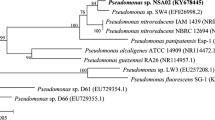Abstract
Objectives
To survey a library of over-expressed nitroreductases to identify those most active with 2,4- and 2,6-dinitrotoluene substrates, as promising candidates for phytoremediation of soils and groundwater contaminated with poly-nitro toluene pollutants.
Results
To indirectly monitor dinitrotoluene reduction we implemented a nitroblue tetrazolium dye screen to compare relative rates of NADPH consumption for 58 nitroreductase candidates, over-expressed in a nitroreductase-deleted strain of Escherichia coli. Although the screen only provides activity data at a single substrate concentration, by altering the substrate concentration and duration of incubation we showed we could first distinguish between more-active and less-active enzymes and then discriminate between the relative rates of reduction exhibited by the most active nitroreductases in the collection. We observed that members of the NfsA and NfsB nitroreductase families were the most active with 2,4-dinitrotoluene, but that only members of the NfsB family reduced 2,6-dinitrotoluene effectively. Two NfsB family members, YfkO from Bacillus subtilis and NfsB from Vibrio vulnificus, appeared especially effective with these substrates. Purification of both enzymes as His6-tagged recombinant proteins enabled in vitro determination of Michaelis–Menten kinetic parameters with each dinitrotoluene substrate.
Conclusions
Vibrio vulnificus NfsB is a particularly promising candidate for bioremediation applications, being ca. fivefold more catalytically efficient with 2,4-dinitrotoluene and over 26-fold more active with 2,6-dinitrotoluene than the benchmark E. coli nitroreductases NfsA and NfsB.


Similar content being viewed by others
References
Akiva E, Copp JN, Tokuriki N, Babbitt PC (2017) Evolutionary and molecular foundations of multiple contemporary functions of the nitroreductase superfamily. Proc Natl Acad Sci USA 114:E9549–E9558
Bolt HM, Degen GH, Dorn SB, Plottner S, Harth V (2006) Genotoxicity and potential carcinogenicity of 2,4,6-trinitrotoluene: structural and toxicological considerations. Rev Environ Heatl 21:217–228
Copp JN, Williams EM, Rich MH, Patterson AV, Smaill JB, Ackerley DF (2014) Toward a high-throughput screening platform for directed evolution of enzymes that activate genotoxic prodrugs. Protein Eng Des Sel 27:399–403
Copp JN et al (2017) Engineering a multifunctional nitroreductase for improved activation of prodrugs and PET probes for cancer gene therapy. Cell Chem Biol 24:391–403
Dontsova KM, Pennington JC, Hayes C, Simunek J, Williford CW (2009) Dissolution and transport of 2,4-DNT and 2,6-DNT from M1 propellant in soil. Chemosphere 77:597–603
Hannink NK, Subramanian M, Rosser SJ, Basran A, Murray JA, Shanks JV, Bruce NC (2007) Enhanced transformation of TNT by tobacco plants expressing a bacterial nitroreductase. Int J Phytoremediation 9:385–401
Mayer KM, Arnold FH (2002) A colorimetric assay to quantify dehydrogenase activity in crude cell lysates. J Biomol Screen 7:135–140
Mowday AM et al (2016) Rational design of an AKR1C3-resistant analog of PR-104 for enzyme-prodrug therapy. Biochem Pharmacol 116:176–187
Prosser GA et al (2010) Discovery and evaluation of Escherichia coli nitroreductases that activate the anti-cancer prodrug CB1954. Biochem Pharmacol 79:678–687
Prosser GA et al (2013) Creation and screening of a multi-family bacterial oxidoreductase library to discover novel nitroreductases that efficiently activate the bioreductive prodrugs CB1954 and PR-104A. Biochem Pharmacol 85:1091–1103
Rich MH, Sharrock AV, Hall KR, Ackerley DF, MacKichan JK (2018) Evaluation of NfsA-like nitroreductases from Neisseria meningitidis and Bartonella henselae for enzyme-prodrug therapy, targeted cellular ablation, and dinitrotoluene bioremediation. Biotechnol Lett 40:359–367
Roldan MD, Perez-Reinado E, Castillo F, Moreno-Vivian C (2008) Reduction of polynitroaromatic compounds: the bacterial nitroreductases. FEMS Microbiol Rev 32:474–500
Van Dillewijn P, Couselo JL, Corredoira E, Delgado A, Wittich RM, Ballester A, Ramos JL (2008) Bioremediation of 2,4,6-trinitrotoluene by bacterial nitroreductase expressing transgenic aspen. Environ Sci Technol 42:7405–7410
Williams EM et al (2015) Nitroreductase gene-directed enzyme prodrug therapy: insights and advances toward clinical utility. Biochem J 471:131–153
Zhang L, Rylott EL, Bruce NC, Strand SE (2019) Genetic modification of western wheatgrass (Pascopyrum smithii) for the phytoremediation of RDX and TNT. Planta 249:1007–1015
Acknowledgements
This work was supported by grants from the Royal Society of New Zealand Marsden Fund (VUW0704 and VUW1502), the UK Biotechnology and Biological Sciences Research Council (BB/P005713/1), and the Strategic Environmental Research and Development Program (ER-2723).
Author information
Authors and Affiliations
Corresponding author
Additional information
Publisher's Note
Springer Nature remains neutral with regard to jurisdictional claims in published maps and institutional affiliations.
Rights and permissions
About this article
Cite this article
Williams, E.M., Sharrock, A.V., Rylott, E.L. et al. A cofactor consumption screen identifies promising NfsB family nitroreductases for dinitrotoluene remediation. Biotechnol Lett 41, 1155–1162 (2019). https://doi.org/10.1007/s10529-019-02716-z
Received:
Accepted:
Published:
Issue Date:
DOI: https://doi.org/10.1007/s10529-019-02716-z




